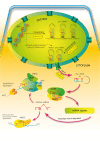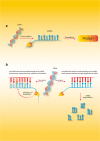The relevance of microRNA in post-infarction left ventricular remodelling and heart failure
- PMID: 30710255
- PMCID: PMC6560007
- DOI: 10.1007/s10741-019-09770-9
The relevance of microRNA in post-infarction left ventricular remodelling and heart failure
Abstract
Myocardial infarction and post-infarction left ventricular remodelling involve a high risk of morbidity and mortality. For this reason, ongoing research is being conducted in order to learn the mechanisms of unfavourable left ventricular remodelling following a myocardial infarction. New biomarkers are also being sought that would allow for early identification of patients with a high risk of post-infarction remodelling and dysfunction of the left ventricle. In recent years, there has been ever more experimental data that confirms the significance of microRNA in cardiovascular diseases. It has been confirmed that microRNAs are stable in systemic circulation, and can be directly measured in patients' blood. It has been found that significant changes occur in the concentrations of various types of microRNA in myocardial infarction and heart failure patients. Various types of microRNA are also currently being intensively researched in terms of their usefulness as markers of cardiomyocyte necrosis, and predictors of the post-infarction heart failure development. This paper is a summary of the current knowledge on the significance of microRNA in post-infarction left ventricular remodelling and heart failure.
Keywords: Heart failure; Left ventricular remodelling; MicroRNA; Myocardial fibrosis; Myocardial infarction.
Conflict of interest statement
The authors declare that they have no conflict of interest.
Figures


References
-
- Pedersen S, Mogelvang R, Bjerre M, Frystyk J, Flyvbjerg A, Galatius S, Sørensen TB, Iversen A, Hvelplund A, Jensen JS. Osteoprotegerin predicts long-term outcome in patients with ST-segment elevation myocardial infarction treated with primary percutaneous coronary intervention. Cardiology. 2012;123:31–38. doi: 10.1159/000339880. - DOI - PubMed
Publication types
MeSH terms
Substances
LinkOut - more resources
Full Text Sources
Medical

